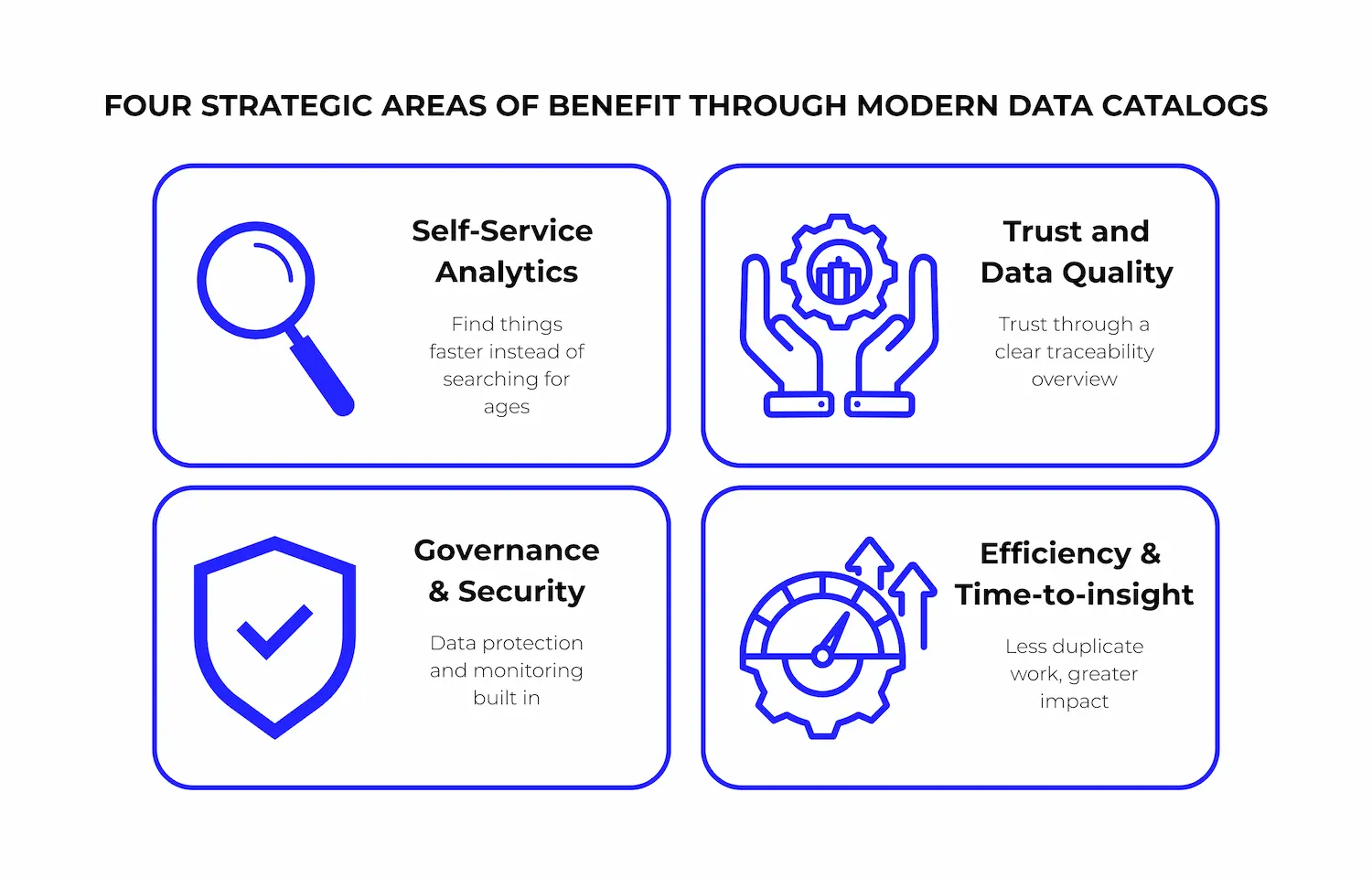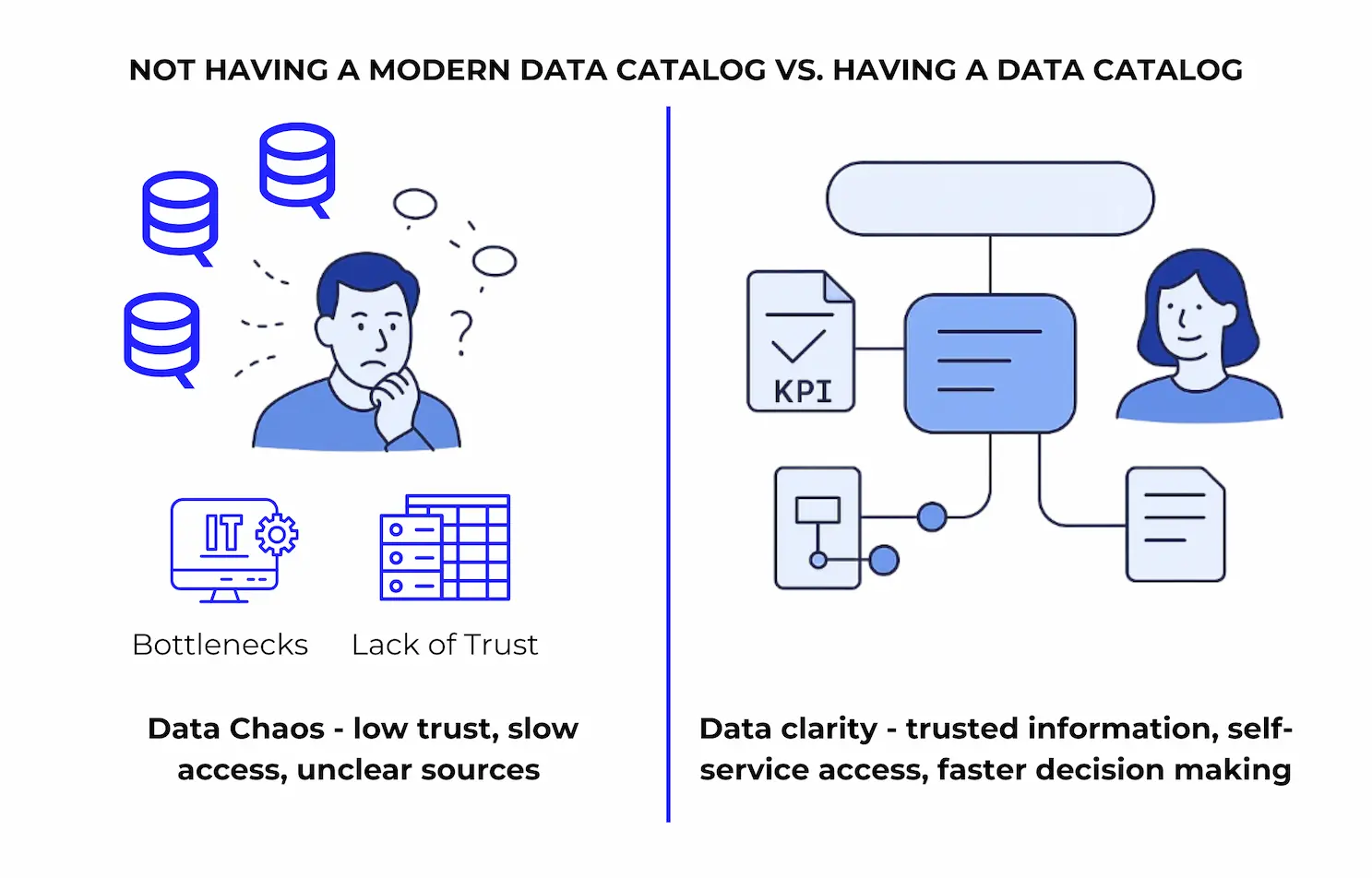From data chaos to decision-making power – with the right catalog strategy
Table of Contents
The silent problem behind slow decisions
Imagine a data-driven company where important decisions are difficult and uncertain. Reporting takes forever, different departments present conflicting KPIs, and the IT department is inundated with ad hoc data requests. The real cause of this sluggishness is usually not a lack of data – on the contrary, there is an abundance of data. The problem is the lack of overview. Employees spend an average of 20–30% of their working time just searching for information because no one knows exactly where the data is located or which report is the right one. The result: decisions are delayed, teams lose confidence in the figures and a lot of duplication of work. The solution: A modern data catalog creates clarity in data chaos and makes data findable, understandable and trustworthy. This enables companies to make faster and more informed decisions.
2. What is a data catalog – and why does it affect more than just IT?
A data catalog is a central catalog of all of a company’s data assets, enriched with information (metadata) about that data. You can think of it as an inventory that clearly lists and describes all data sources from databases and tables to files, reports and dashboards. This includes technical details, technical descriptions and information about the origin of the data. In the past, this was purely an IT issue. Today, a modern data catalog is aimed at the entire company: analysts, marketers, controllers, product managers, data protection officers. They all benefit when data is easy to find and understand. Only with this shared data foundation can all departments make informed decisions. A modern data catalog is therefore not just a technical tool, but an operational business enabler.
3. Four strategic areas of benefit for companies
3.1 Self-service analytics & data findability
In many companies access to data is bureaucratic and slow. Specialist departments have to submit requests to IT and often wait days for a response or for reports to be provided. This frustrates users and puts a strain on IT. A data catalog fundamentally changes this picture. It makes data sources visible, searchable and understandable via a user-friendly interface. Users can find relevant data, reports and KPIs on their own without having to rely on support. This not only reduces dependence on IT, but also promotes a genuine self-service mentality within the company. The result: faster decisions, fewer queries and increased utilization of existing data sets.
3.2 Trust & data quality
Many data-based decisions fail not because of data availability, but because of a lack of trust. Who calculated this figure? Has the data been updated? Is this the right source? A modern data catalog addresses these uncertainties with transparency.
-
It shows the origin of data (lineage) – from the source system to the dashboard.
-
It assigns responsibilities – who maintains this data set?
-
It contains descriptions, comment functions, ratings and quality indicators.
This creates an environment in which users no longer have to question whether they can trust the figures. Instead, they know why they are trustworthy.
3.3 Governance, compliance, and security
Regulatory requirements are increasing, as are expectations for data protection, audit readiness and access management. A data catalog provides the necessary overview and control.
-
Automatic classification of sensitive data (e.g. personal information)
-
Role-based access control and complete logging
-
Support for GDPR, ISO and industry specific requirements
A good catalog shows at the touch of a button where sensitive data is located, who has access to it and how it has been used. It simplifies reviews, audits and internal controls.
3.4 Efficiency & time-to-insight
As every analyst knows, the same analysis is performed multiple times because no one knows that it already exists. Or it takes days to understand a KPI because the definition is unclear. A data catalog brings structure to these processes. The reusability of existing data models, reports and dashboards reduces duplication of work. The time from data requirement to insight, the “time-to-insight”,is significantly reduced. This pays off directly in terms of a company’s speed of innovation and response.

4. Business scenarios: How individual teams benefit from data catalogs
The advantages of a modern data catalog are not abstract they can be clearly translated into the everyday work of various departments:
Controlling & reporting
-
Clear definitions & sources of KPIs: A central location for KPI definitions ensures consistency in reports and evaluations.
-
Faster monthly closings: Financial data is clearly assigned and easy to find, reducing the need for reconciliation.
-
Fewer queries: When reports are documented in a traceable manner, many queries to the BI team are eliminated.
Marketing & Sales
-
Consistent target group segments: All teams work with the same definitions e.g.for “existing customer,” “lead,” or “churn.”
-
Validated campaign KPIs: Campaign metrics are based on approved data sources, which builds trust in performance evaluations.
-
Higher ROI: Clearly defined data leads to more targeted campaigns and less wasted coverage.
Product management
-
Better usage measurement: Features can be analyzed more effectively when it is clear what events mean.
-
Clarity about tracking sources: A catalog shows how usage data is generated and whether it is reliable.
-
Faster release of data-based features: Less room for interpretation = faster decisions.
Data protection & legal
-
Automatic identification of sensitive data: PII (e.g. email, address) is automatically recognized and tagged.
-
Central overview & control: Data protection officers have access to all relevant information in one place.
-
Reduced audit and penalty risk: Complete documentation protects against legal consequences.
Strategy & M&A
-
Lineage & ownership demonstrate data maturity: A structured catalog signals to potential buyers that this company has its data under control.
-
Trustworthy metrics in due diligence processes: All figures are documented in a traceable manner, which increases credibility.
-
Data as an asset: A well thought-out data structure increases the value of the company, both operationally and on the balance sheet.
These scenarios make it clear that the benefits of a data catalog are broad and affect not only data experts, but virtually every role in the company.
5. What modern data catalogs really need to deliver
Many tools remain superficial. Metadata maintenance is manual, lineage is incomplete, and business users hardly understand the content.
A modern data catalog must offer:
-
Automatic lineage & impact analysis: Data flows must be transparently traceable, ideally down to the column level.
-
AI-powered discoverability & semantic search: Users should be able to find relevant content even without technical terms.
-
Self-service use without technical know-how: A simple user interface makes the catalog accessible to everyone.
-
Integrated governance & access control: Compliance must run seamlessly within the system, not as an additional effort.
-
Seamless integration: The catalog must be able to integrate with existing BI, ELT, and transformation tools.
6. Coalesce Catalog: The difference in workflow
Why Coalesce?
-
Combines catalog, transformation, and governance in one platform.
-
Changes to the code automatically generate lineage, no extra effort.
-
Metadata is created as a by-product, not through separate maintenance.
Special features:
-
Automated description of tables and KPIs.
-
AI-powered answers to business questions directly from the catalog.
-
Role-based view of data tailored for technical and business users.
-
Integration with existing tools such as Snowflake, Looker, etc.
The Coalesce Catalog rethinks workflow: Instead of treating data and documentation separately, the catalog is created “in action” as an integral part of the transformation. This not only makes it more up-to-date, but also more sustainable.
7. Economic added value: Measurable results from practice
-
30–40% time savings for analysts thanks to fewer searches and queries.
-
Higher data utilization through self-service access in specialist departments.
-
70% less audit effort thanks to automated governance and documentation.
-
Data usable as a balance sheet asset e.g. in M&A processes or as a basis for new data-driven products.
Companies report faster release cycles, higher data quality, and better decisions because the data is not only there, but can also be understood and used.

Conclusion: Data clarity as a competitive advantage
Modern companies don’t need “more” data, they need more clarity and context. Only those who truly understand data can make quick and confident decisions. A powerful data catalog is the key to this. It connects business and IT, creates transparency and trust and translates data into real value. With its integrated approach, Coalesce provides a catalog that fits directly into work processes and is therefore particularly efficient. Conclusion: If you want to be successful in a data-driven world, you need a solid foundation and that starts with a modern data catalog.

